BUSN 104 Module Report: CommInsure Practices and Financial Decisions
VerifiedAdded on 2023/06/05
|11
|2769
|195
Report
AI Summary
This report examines the relationship between CommInsure's practices, financial decisions, and the corporate social responsibility (CSR) of the Commonwealth Bank of Australia (CBA). It explores the significance of the social behavior index, comprising elements like the Don Jones sustainability index and Global Reporting Initiative, in influencing a bank's financial performance. The report details CommInsure's practices, which are customer-centric and aligned with CBA's CSR initiatives, including education, innovation, and good business practices. It also discusses the ethical principles governing financial institutions, highlighting the importance of transparency, professional standards, and conflict resolution. The analysis covers how CBA integrates sustainability, social responsibility, and ethical conduct into its operations to meet both organizational and community needs. The report concludes by emphasizing the bidirectional relationship between financial management and CSR, demonstrating how effective CSR practices contribute to improved financial outcomes.
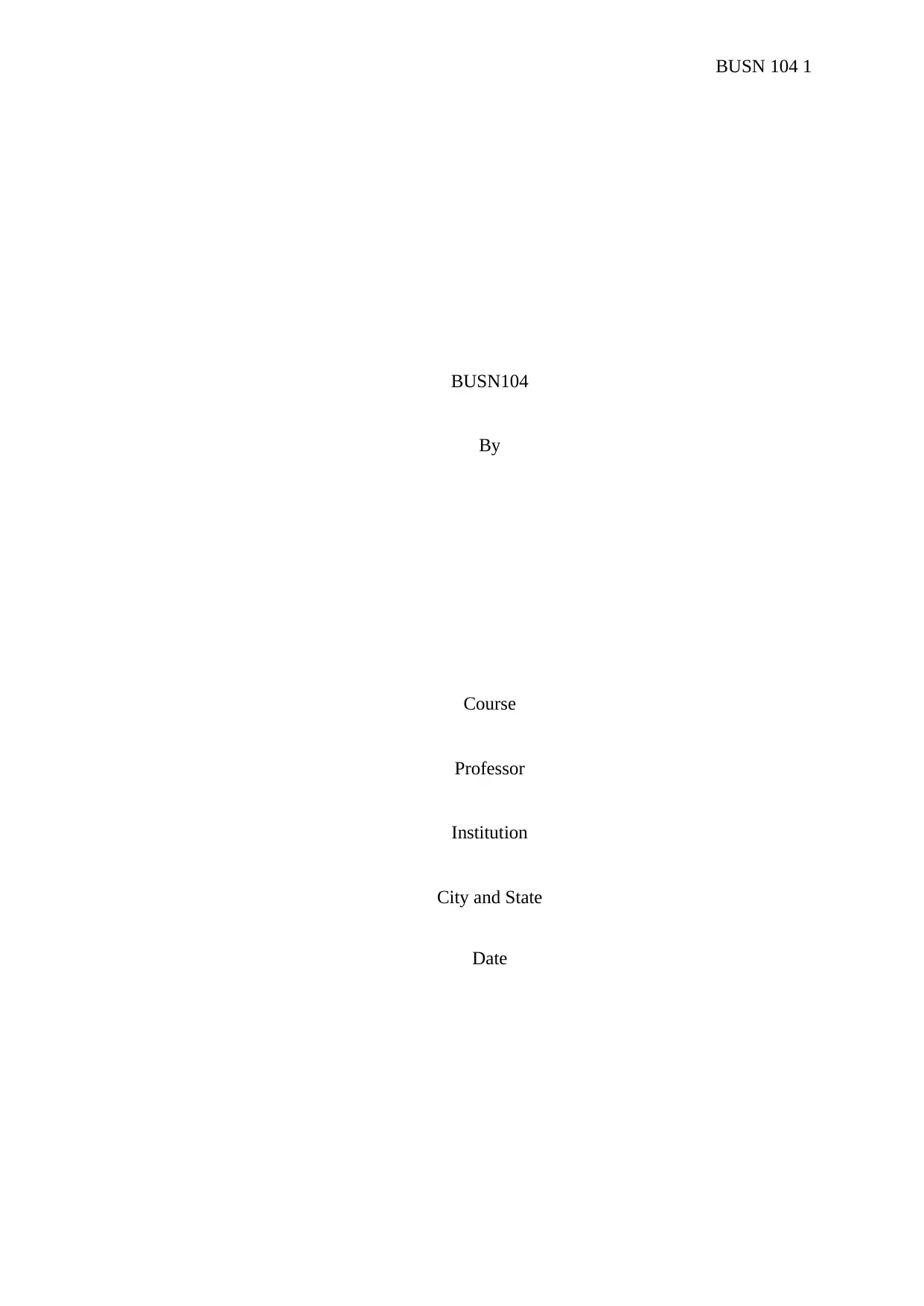
BUSN 104 1
BUSN104
By
Course
Professor
Institution
City and State
Date
BUSN104
By
Course
Professor
Institution
City and State
Date
Paraphrase This Document
Need a fresh take? Get an instant paraphrase of this document with our AI Paraphraser
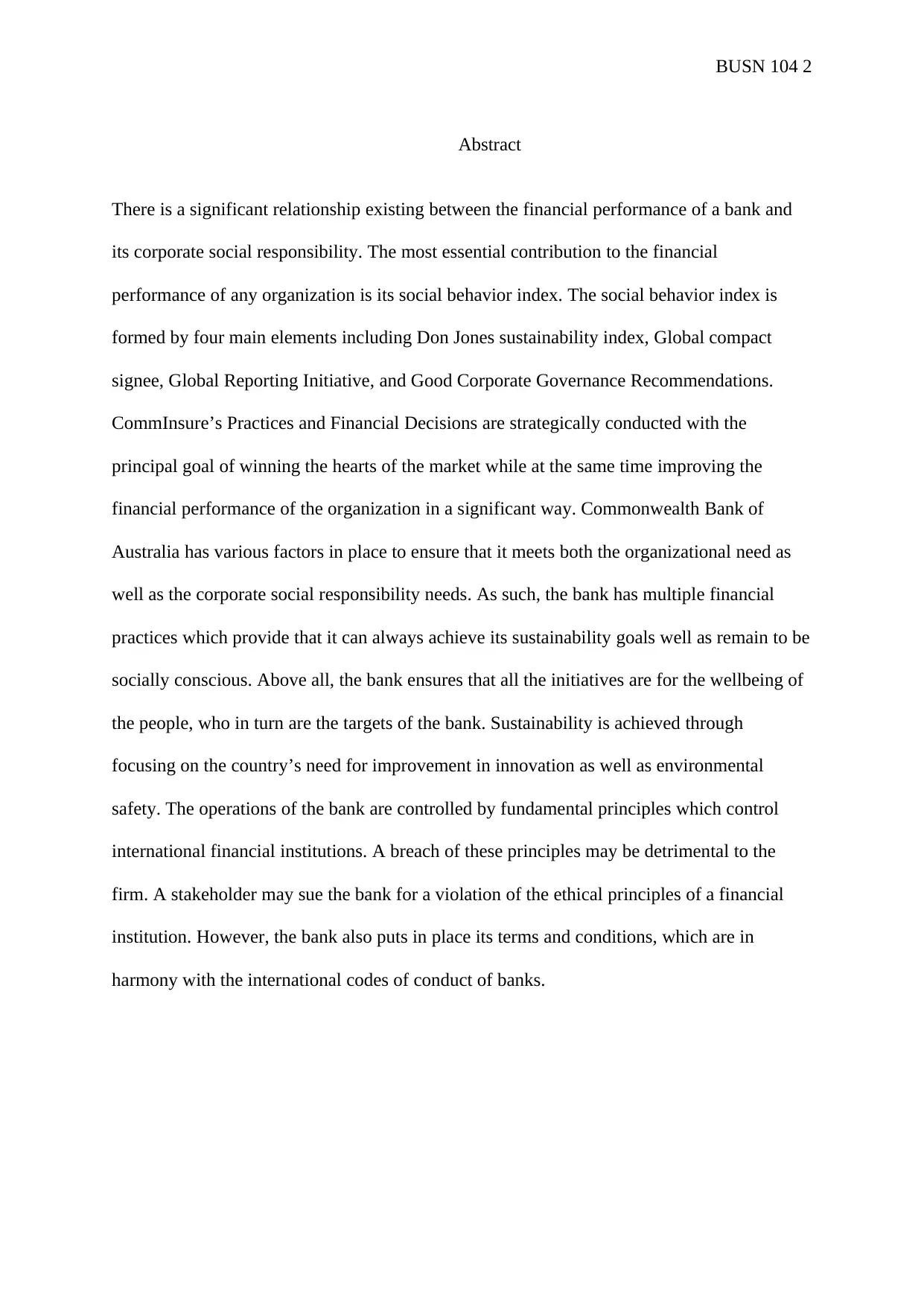
BUSN 104 2
Abstract
There is a significant relationship existing between the financial performance of a bank and
its corporate social responsibility. The most essential contribution to the financial
performance of any organization is its social behavior index. The social behavior index is
formed by four main elements including Don Jones sustainability index, Global compact
signee, Global Reporting Initiative, and Good Corporate Governance Recommendations.
CommInsure’s Practices and Financial Decisions are strategically conducted with the
principal goal of winning the hearts of the market while at the same time improving the
financial performance of the organization in a significant way. Commonwealth Bank of
Australia has various factors in place to ensure that it meets both the organizational need as
well as the corporate social responsibility needs. As such, the bank has multiple financial
practices which provide that it can always achieve its sustainability goals well as remain to be
socially conscious. Above all, the bank ensures that all the initiatives are for the wellbeing of
the people, who in turn are the targets of the bank. Sustainability is achieved through
focusing on the country’s need for improvement in innovation as well as environmental
safety. The operations of the bank are controlled by fundamental principles which control
international financial institutions. A breach of these principles may be detrimental to the
firm. A stakeholder may sue the bank for a violation of the ethical principles of a financial
institution. However, the bank also puts in place its terms and conditions, which are in
harmony with the international codes of conduct of banks.
Abstract
There is a significant relationship existing between the financial performance of a bank and
its corporate social responsibility. The most essential contribution to the financial
performance of any organization is its social behavior index. The social behavior index is
formed by four main elements including Don Jones sustainability index, Global compact
signee, Global Reporting Initiative, and Good Corporate Governance Recommendations.
CommInsure’s Practices and Financial Decisions are strategically conducted with the
principal goal of winning the hearts of the market while at the same time improving the
financial performance of the organization in a significant way. Commonwealth Bank of
Australia has various factors in place to ensure that it meets both the organizational need as
well as the corporate social responsibility needs. As such, the bank has multiple financial
practices which provide that it can always achieve its sustainability goals well as remain to be
socially conscious. Above all, the bank ensures that all the initiatives are for the wellbeing of
the people, who in turn are the targets of the bank. Sustainability is achieved through
focusing on the country’s need for improvement in innovation as well as environmental
safety. The operations of the bank are controlled by fundamental principles which control
international financial institutions. A breach of these principles may be detrimental to the
firm. A stakeholder may sue the bank for a violation of the ethical principles of a financial
institution. However, the bank also puts in place its terms and conditions, which are in
harmony with the international codes of conduct of banks.
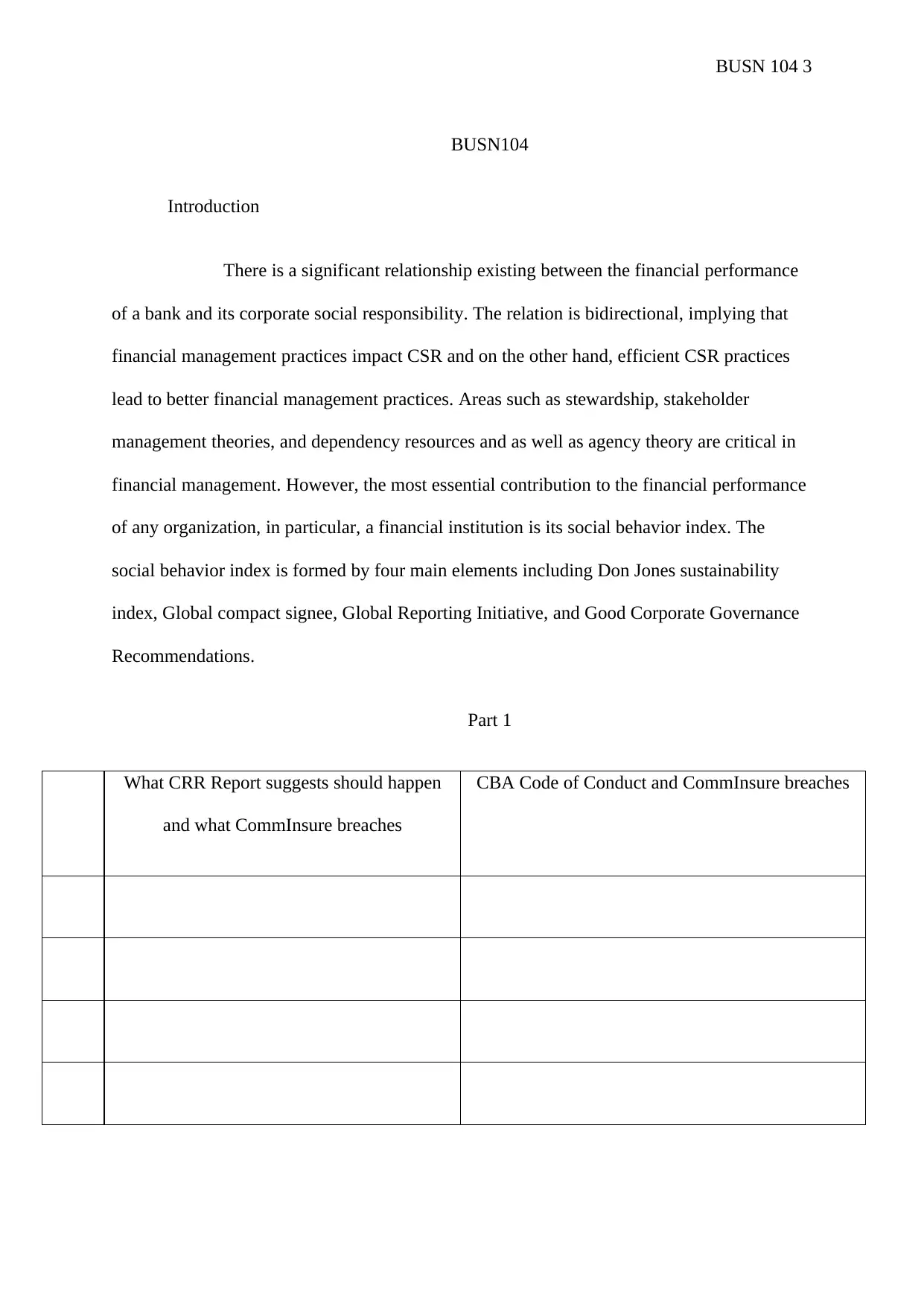
BUSN 104 3
BUSN104
Introduction
There is a significant relationship existing between the financial performance
of a bank and its corporate social responsibility. The relation is bidirectional, implying that
financial management practices impact CSR and on the other hand, efficient CSR practices
lead to better financial management practices. Areas such as stewardship, stakeholder
management theories, and dependency resources and as well as agency theory are critical in
financial management. However, the most essential contribution to the financial performance
of any organization, in particular, a financial institution is its social behavior index. The
social behavior index is formed by four main elements including Don Jones sustainability
index, Global compact signee, Global Reporting Initiative, and Good Corporate Governance
Recommendations.
Part 1
What CRR Report suggests should happen
and what CommInsure breaches
CBA Code of Conduct and CommInsure breaches
BUSN104
Introduction
There is a significant relationship existing between the financial performance
of a bank and its corporate social responsibility. The relation is bidirectional, implying that
financial management practices impact CSR and on the other hand, efficient CSR practices
lead to better financial management practices. Areas such as stewardship, stakeholder
management theories, and dependency resources and as well as agency theory are critical in
financial management. However, the most essential contribution to the financial performance
of any organization, in particular, a financial institution is its social behavior index. The
social behavior index is formed by four main elements including Don Jones sustainability
index, Global compact signee, Global Reporting Initiative, and Good Corporate Governance
Recommendations.
Part 1
What CRR Report suggests should happen
and what CommInsure breaches
CBA Code of Conduct and CommInsure breaches
⊘ This is a preview!⊘
Do you want full access?
Subscribe today to unlock all pages.

Trusted by 1+ million students worldwide
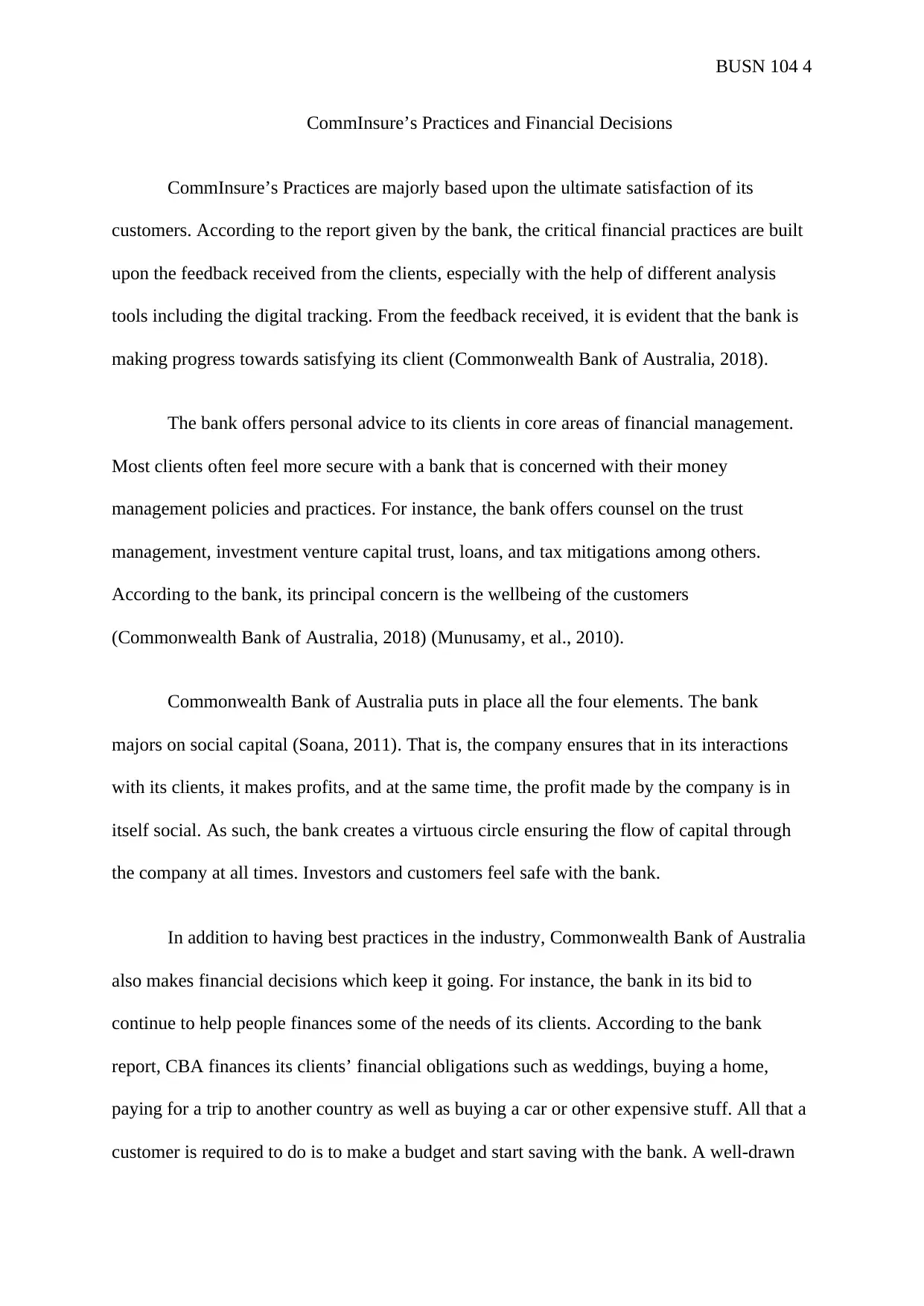
BUSN 104 4
CommInsure’s Practices and Financial Decisions
CommInsure’s Practices are majorly based upon the ultimate satisfaction of its
customers. According to the report given by the bank, the critical financial practices are built
upon the feedback received from the clients, especially with the help of different analysis
tools including the digital tracking. From the feedback received, it is evident that the bank is
making progress towards satisfying its client (Commonwealth Bank of Australia, 2018).
The bank offers personal advice to its clients in core areas of financial management.
Most clients often feel more secure with a bank that is concerned with their money
management policies and practices. For instance, the bank offers counsel on the trust
management, investment venture capital trust, loans, and tax mitigations among others.
According to the bank, its principal concern is the wellbeing of the customers
(Commonwealth Bank of Australia, 2018) (Munusamy, et al., 2010).
Commonwealth Bank of Australia puts in place all the four elements. The bank
majors on social capital (Soana, 2011). That is, the company ensures that in its interactions
with its clients, it makes profits, and at the same time, the profit made by the company is in
itself social. As such, the bank creates a virtuous circle ensuring the flow of capital through
the company at all times. Investors and customers feel safe with the bank.
In addition to having best practices in the industry, Commonwealth Bank of Australia
also makes financial decisions which keep it going. For instance, the bank in its bid to
continue to help people finances some of the needs of its clients. According to the bank
report, CBA finances its clients’ financial obligations such as weddings, buying a home,
paying for a trip to another country as well as buying a car or other expensive stuff. All that a
customer is required to do is to make a budget and start saving with the bank. A well-drawn
CommInsure’s Practices and Financial Decisions
CommInsure’s Practices are majorly based upon the ultimate satisfaction of its
customers. According to the report given by the bank, the critical financial practices are built
upon the feedback received from the clients, especially with the help of different analysis
tools including the digital tracking. From the feedback received, it is evident that the bank is
making progress towards satisfying its client (Commonwealth Bank of Australia, 2018).
The bank offers personal advice to its clients in core areas of financial management.
Most clients often feel more secure with a bank that is concerned with their money
management policies and practices. For instance, the bank offers counsel on the trust
management, investment venture capital trust, loans, and tax mitigations among others.
According to the bank, its principal concern is the wellbeing of the customers
(Commonwealth Bank of Australia, 2018) (Munusamy, et al., 2010).
Commonwealth Bank of Australia puts in place all the four elements. The bank
majors on social capital (Soana, 2011). That is, the company ensures that in its interactions
with its clients, it makes profits, and at the same time, the profit made by the company is in
itself social. As such, the bank creates a virtuous circle ensuring the flow of capital through
the company at all times. Investors and customers feel safe with the bank.
In addition to having best practices in the industry, Commonwealth Bank of Australia
also makes financial decisions which keep it going. For instance, the bank in its bid to
continue to help people finances some of the needs of its clients. According to the bank
report, CBA finances its clients’ financial obligations such as weddings, buying a home,
paying for a trip to another country as well as buying a car or other expensive stuff. All that a
customer is required to do is to make a budget and start saving with the bank. A well-drawn
Paraphrase This Document
Need a fresh take? Get an instant paraphrase of this document with our AI Paraphraser
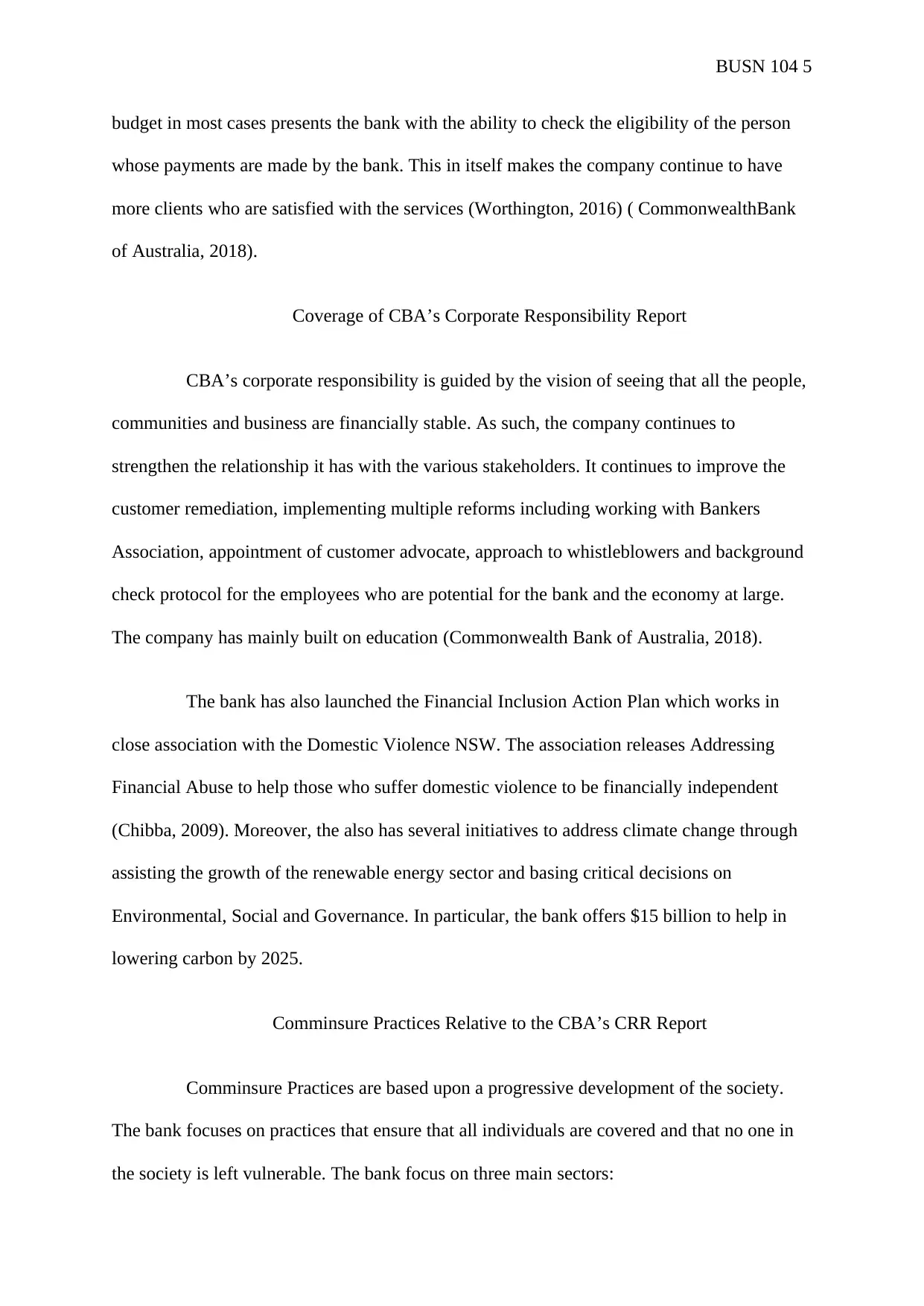
BUSN 104 5
budget in most cases presents the bank with the ability to check the eligibility of the person
whose payments are made by the bank. This in itself makes the company continue to have
more clients who are satisfied with the services (Worthington, 2016) ( CommonwealthBank
of Australia, 2018).
Coverage of CBA’s Corporate Responsibility Report
CBA’s corporate responsibility is guided by the vision of seeing that all the people,
communities and business are financially stable. As such, the company continues to
strengthen the relationship it has with the various stakeholders. It continues to improve the
customer remediation, implementing multiple reforms including working with Bankers
Association, appointment of customer advocate, approach to whistleblowers and background
check protocol for the employees who are potential for the bank and the economy at large.
The company has mainly built on education (Commonwealth Bank of Australia, 2018).
The bank has also launched the Financial Inclusion Action Plan which works in
close association with the Domestic Violence NSW. The association releases Addressing
Financial Abuse to help those who suffer domestic violence to be financially independent
(Chibba, 2009). Moreover, the also has several initiatives to address climate change through
assisting the growth of the renewable energy sector and basing critical decisions on
Environmental, Social and Governance. In particular, the bank offers $15 billion to help in
lowering carbon by 2025.
Comminsure Practices Relative to the CBA’s CRR Report
Comminsure Practices are based upon a progressive development of the society.
The bank focuses on practices that ensure that all individuals are covered and that no one in
the society is left vulnerable. The bank focus on three main sectors:
budget in most cases presents the bank with the ability to check the eligibility of the person
whose payments are made by the bank. This in itself makes the company continue to have
more clients who are satisfied with the services (Worthington, 2016) ( CommonwealthBank
of Australia, 2018).
Coverage of CBA’s Corporate Responsibility Report
CBA’s corporate responsibility is guided by the vision of seeing that all the people,
communities and business are financially stable. As such, the company continues to
strengthen the relationship it has with the various stakeholders. It continues to improve the
customer remediation, implementing multiple reforms including working with Bankers
Association, appointment of customer advocate, approach to whistleblowers and background
check protocol for the employees who are potential for the bank and the economy at large.
The company has mainly built on education (Commonwealth Bank of Australia, 2018).
The bank has also launched the Financial Inclusion Action Plan which works in
close association with the Domestic Violence NSW. The association releases Addressing
Financial Abuse to help those who suffer domestic violence to be financially independent
(Chibba, 2009). Moreover, the also has several initiatives to address climate change through
assisting the growth of the renewable energy sector and basing critical decisions on
Environmental, Social and Governance. In particular, the bank offers $15 billion to help in
lowering carbon by 2025.
Comminsure Practices Relative to the CBA’s CRR Report
Comminsure Practices are based upon a progressive development of the society.
The bank focuses on practices that ensure that all individuals are covered and that no one in
the society is left vulnerable. The bank focus on three main sectors:
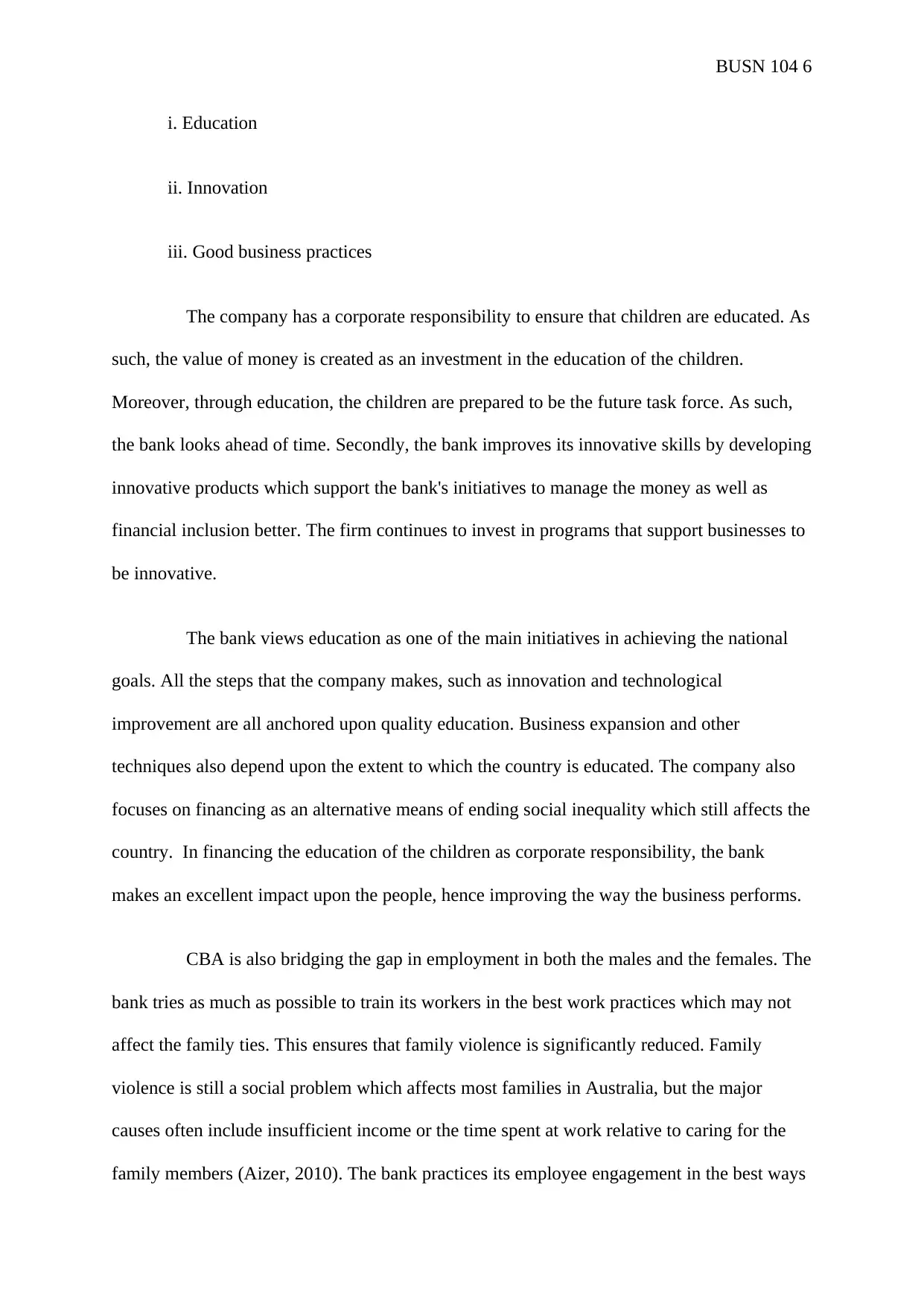
BUSN 104 6
i. Education
ii. Innovation
iii. Good business practices
The company has a corporate responsibility to ensure that children are educated. As
such, the value of money is created as an investment in the education of the children.
Moreover, through education, the children are prepared to be the future task force. As such,
the bank looks ahead of time. Secondly, the bank improves its innovative skills by developing
innovative products which support the bank's initiatives to manage the money as well as
financial inclusion better. The firm continues to invest in programs that support businesses to
be innovative.
The bank views education as one of the main initiatives in achieving the national
goals. All the steps that the company makes, such as innovation and technological
improvement are all anchored upon quality education. Business expansion and other
techniques also depend upon the extent to which the country is educated. The company also
focuses on financing as an alternative means of ending social inequality which still affects the
country. In financing the education of the children as corporate responsibility, the bank
makes an excellent impact upon the people, hence improving the way the business performs.
CBA is also bridging the gap in employment in both the males and the females. The
bank tries as much as possible to train its workers in the best work practices which may not
affect the family ties. This ensures that family violence is significantly reduced. Family
violence is still a social problem which affects most families in Australia, but the major
causes often include insufficient income or the time spent at work relative to caring for the
family members (Aizer, 2010). The bank practices its employee engagement in the best ways
i. Education
ii. Innovation
iii. Good business practices
The company has a corporate responsibility to ensure that children are educated. As
such, the value of money is created as an investment in the education of the children.
Moreover, through education, the children are prepared to be the future task force. As such,
the bank looks ahead of time. Secondly, the bank improves its innovative skills by developing
innovative products which support the bank's initiatives to manage the money as well as
financial inclusion better. The firm continues to invest in programs that support businesses to
be innovative.
The bank views education as one of the main initiatives in achieving the national
goals. All the steps that the company makes, such as innovation and technological
improvement are all anchored upon quality education. Business expansion and other
techniques also depend upon the extent to which the country is educated. The company also
focuses on financing as an alternative means of ending social inequality which still affects the
country. In financing the education of the children as corporate responsibility, the bank
makes an excellent impact upon the people, hence improving the way the business performs.
CBA is also bridging the gap in employment in both the males and the females. The
bank tries as much as possible to train its workers in the best work practices which may not
affect the family ties. This ensures that family violence is significantly reduced. Family
violence is still a social problem which affects most families in Australia, but the major
causes often include insufficient income or the time spent at work relative to caring for the
family members (Aizer, 2010). The bank practices its employee engagement in the best ways
⊘ This is a preview!⊘
Do you want full access?
Subscribe today to unlock all pages.

Trusted by 1+ million students worldwide
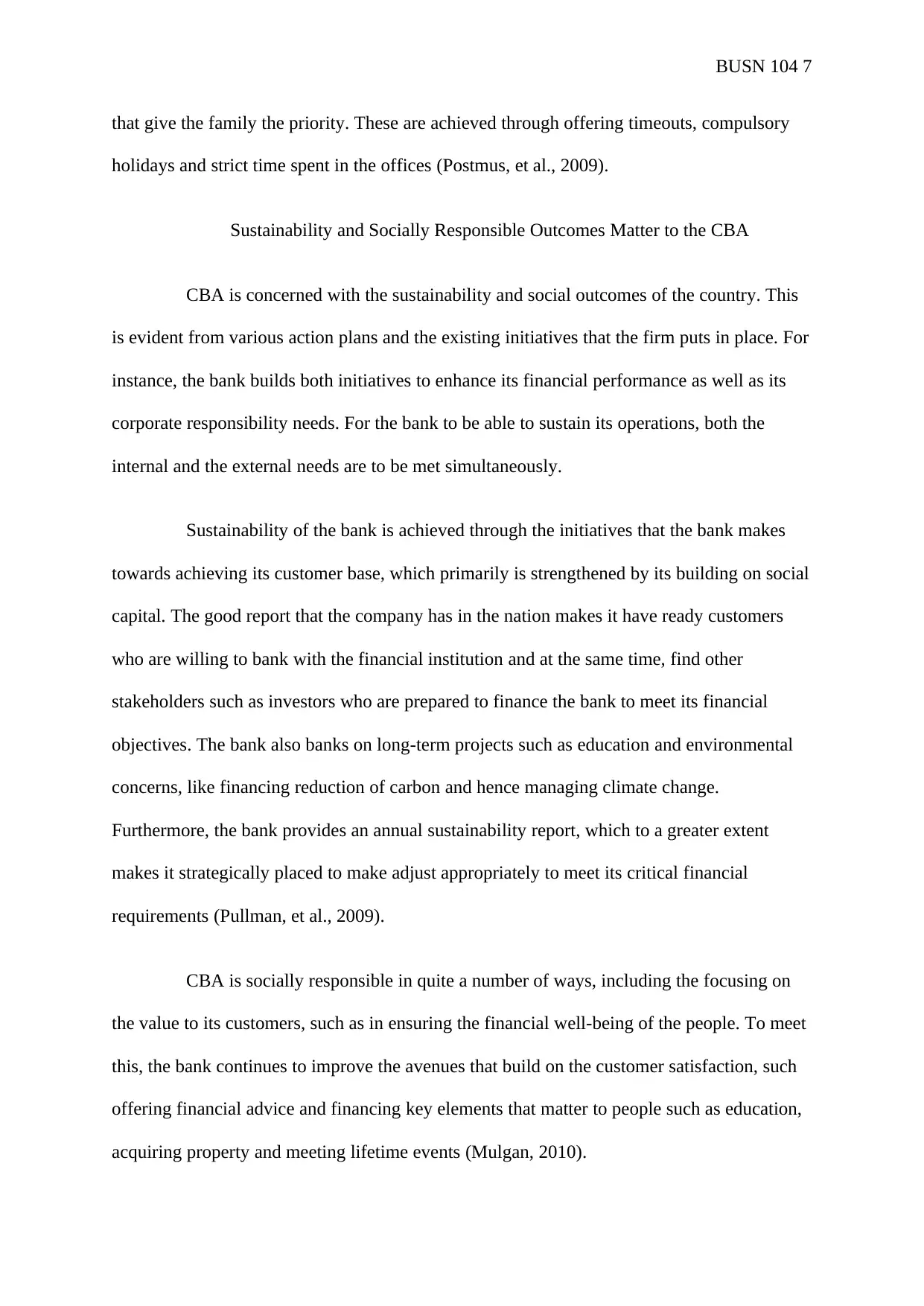
BUSN 104 7
that give the family the priority. These are achieved through offering timeouts, compulsory
holidays and strict time spent in the offices (Postmus, et al., 2009).
Sustainability and Socially Responsible Outcomes Matter to the CBA
CBA is concerned with the sustainability and social outcomes of the country. This
is evident from various action plans and the existing initiatives that the firm puts in place. For
instance, the bank builds both initiatives to enhance its financial performance as well as its
corporate responsibility needs. For the bank to be able to sustain its operations, both the
internal and the external needs are to be met simultaneously.
Sustainability of the bank is achieved through the initiatives that the bank makes
towards achieving its customer base, which primarily is strengthened by its building on social
capital. The good report that the company has in the nation makes it have ready customers
who are willing to bank with the financial institution and at the same time, find other
stakeholders such as investors who are prepared to finance the bank to meet its financial
objectives. The bank also banks on long-term projects such as education and environmental
concerns, like financing reduction of carbon and hence managing climate change.
Furthermore, the bank provides an annual sustainability report, which to a greater extent
makes it strategically placed to make adjust appropriately to meet its critical financial
requirements (Pullman, et al., 2009).
CBA is socially responsible in quite a number of ways, including the focusing on
the value to its customers, such as in ensuring the financial well-being of the people. To meet
this, the bank continues to improve the avenues that build on the customer satisfaction, such
offering financial advice and financing key elements that matter to people such as education,
acquiring property and meeting lifetime events (Mulgan, 2010).
that give the family the priority. These are achieved through offering timeouts, compulsory
holidays and strict time spent in the offices (Postmus, et al., 2009).
Sustainability and Socially Responsible Outcomes Matter to the CBA
CBA is concerned with the sustainability and social outcomes of the country. This
is evident from various action plans and the existing initiatives that the firm puts in place. For
instance, the bank builds both initiatives to enhance its financial performance as well as its
corporate responsibility needs. For the bank to be able to sustain its operations, both the
internal and the external needs are to be met simultaneously.
Sustainability of the bank is achieved through the initiatives that the bank makes
towards achieving its customer base, which primarily is strengthened by its building on social
capital. The good report that the company has in the nation makes it have ready customers
who are willing to bank with the financial institution and at the same time, find other
stakeholders such as investors who are prepared to finance the bank to meet its financial
objectives. The bank also banks on long-term projects such as education and environmental
concerns, like financing reduction of carbon and hence managing climate change.
Furthermore, the bank provides an annual sustainability report, which to a greater extent
makes it strategically placed to make adjust appropriately to meet its critical financial
requirements (Pullman, et al., 2009).
CBA is socially responsible in quite a number of ways, including the focusing on
the value to its customers, such as in ensuring the financial well-being of the people. To meet
this, the bank continues to improve the avenues that build on the customer satisfaction, such
offering financial advice and financing key elements that matter to people such as education,
acquiring property and meeting lifetime events (Mulgan, 2010).
Paraphrase This Document
Need a fresh take? Get an instant paraphrase of this document with our AI Paraphraser
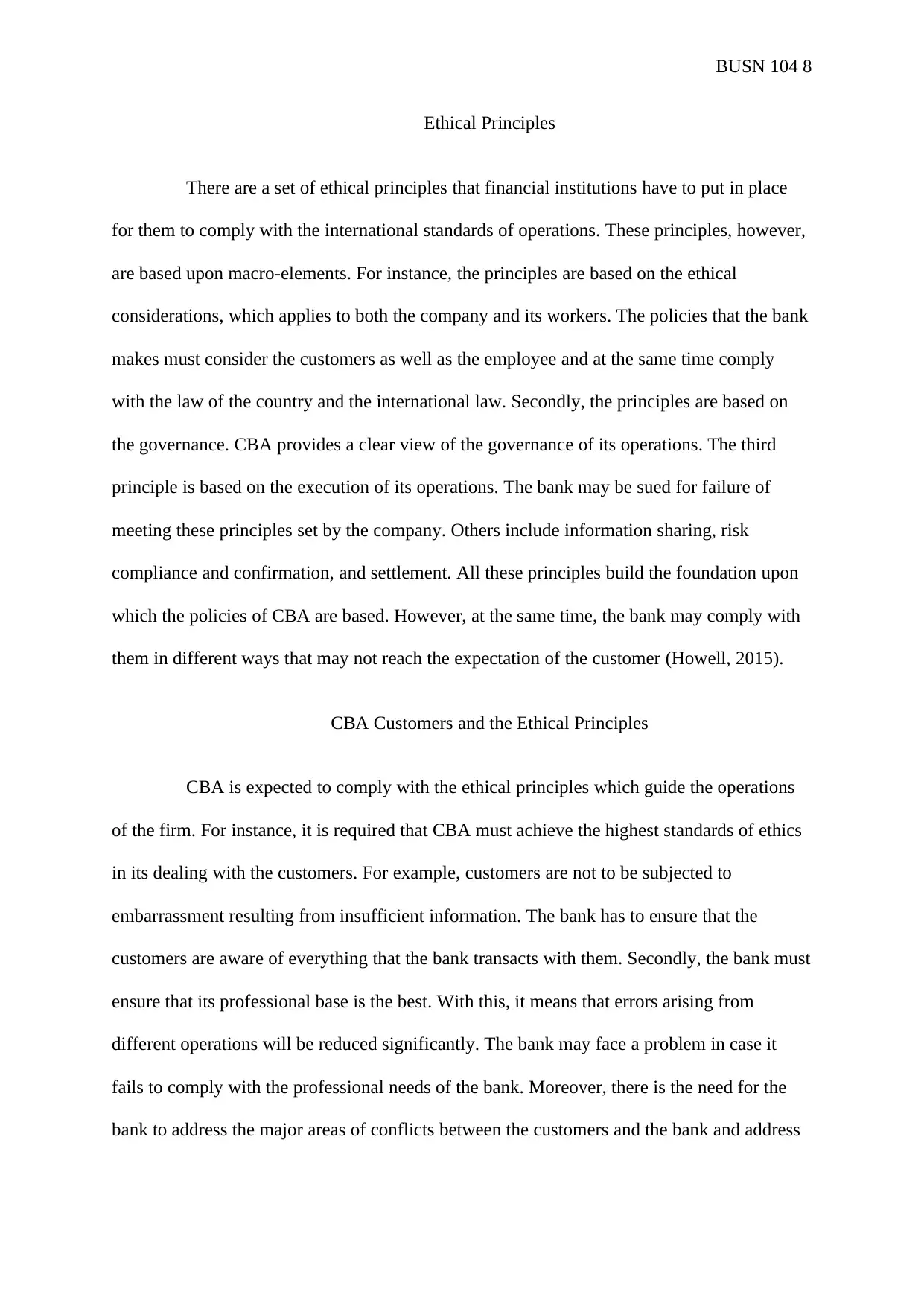
BUSN 104 8
Ethical Principles
There are a set of ethical principles that financial institutions have to put in place
for them to comply with the international standards of operations. These principles, however,
are based upon macro-elements. For instance, the principles are based on the ethical
considerations, which applies to both the company and its workers. The policies that the bank
makes must consider the customers as well as the employee and at the same time comply
with the law of the country and the international law. Secondly, the principles are based on
the governance. CBA provides a clear view of the governance of its operations. The third
principle is based on the execution of its operations. The bank may be sued for failure of
meeting these principles set by the company. Others include information sharing, risk
compliance and confirmation, and settlement. All these principles build the foundation upon
which the policies of CBA are based. However, at the same time, the bank may comply with
them in different ways that may not reach the expectation of the customer (Howell, 2015).
CBA Customers and the Ethical Principles
CBA is expected to comply with the ethical principles which guide the operations
of the firm. For instance, it is required that CBA must achieve the highest standards of ethics
in its dealing with the customers. For example, customers are not to be subjected to
embarrassment resulting from insufficient information. The bank has to ensure that the
customers are aware of everything that the bank transacts with them. Secondly, the bank must
ensure that its professional base is the best. With this, it means that errors arising from
different operations will be reduced significantly. The bank may face a problem in case it
fails to comply with the professional needs of the bank. Moreover, there is the need for the
bank to address the major areas of conflicts between the customers and the bank and address
Ethical Principles
There are a set of ethical principles that financial institutions have to put in place
for them to comply with the international standards of operations. These principles, however,
are based upon macro-elements. For instance, the principles are based on the ethical
considerations, which applies to both the company and its workers. The policies that the bank
makes must consider the customers as well as the employee and at the same time comply
with the law of the country and the international law. Secondly, the principles are based on
the governance. CBA provides a clear view of the governance of its operations. The third
principle is based on the execution of its operations. The bank may be sued for failure of
meeting these principles set by the company. Others include information sharing, risk
compliance and confirmation, and settlement. All these principles build the foundation upon
which the policies of CBA are based. However, at the same time, the bank may comply with
them in different ways that may not reach the expectation of the customer (Howell, 2015).
CBA Customers and the Ethical Principles
CBA is expected to comply with the ethical principles which guide the operations
of the firm. For instance, it is required that CBA must achieve the highest standards of ethics
in its dealing with the customers. For example, customers are not to be subjected to
embarrassment resulting from insufficient information. The bank has to ensure that the
customers are aware of everything that the bank transacts with them. Secondly, the bank must
ensure that its professional base is the best. With this, it means that errors arising from
different operations will be reduced significantly. The bank may face a problem in case it
fails to comply with the professional needs of the bank. Moreover, there is the need for the
bank to address the major areas of conflicts between the customers and the bank and address
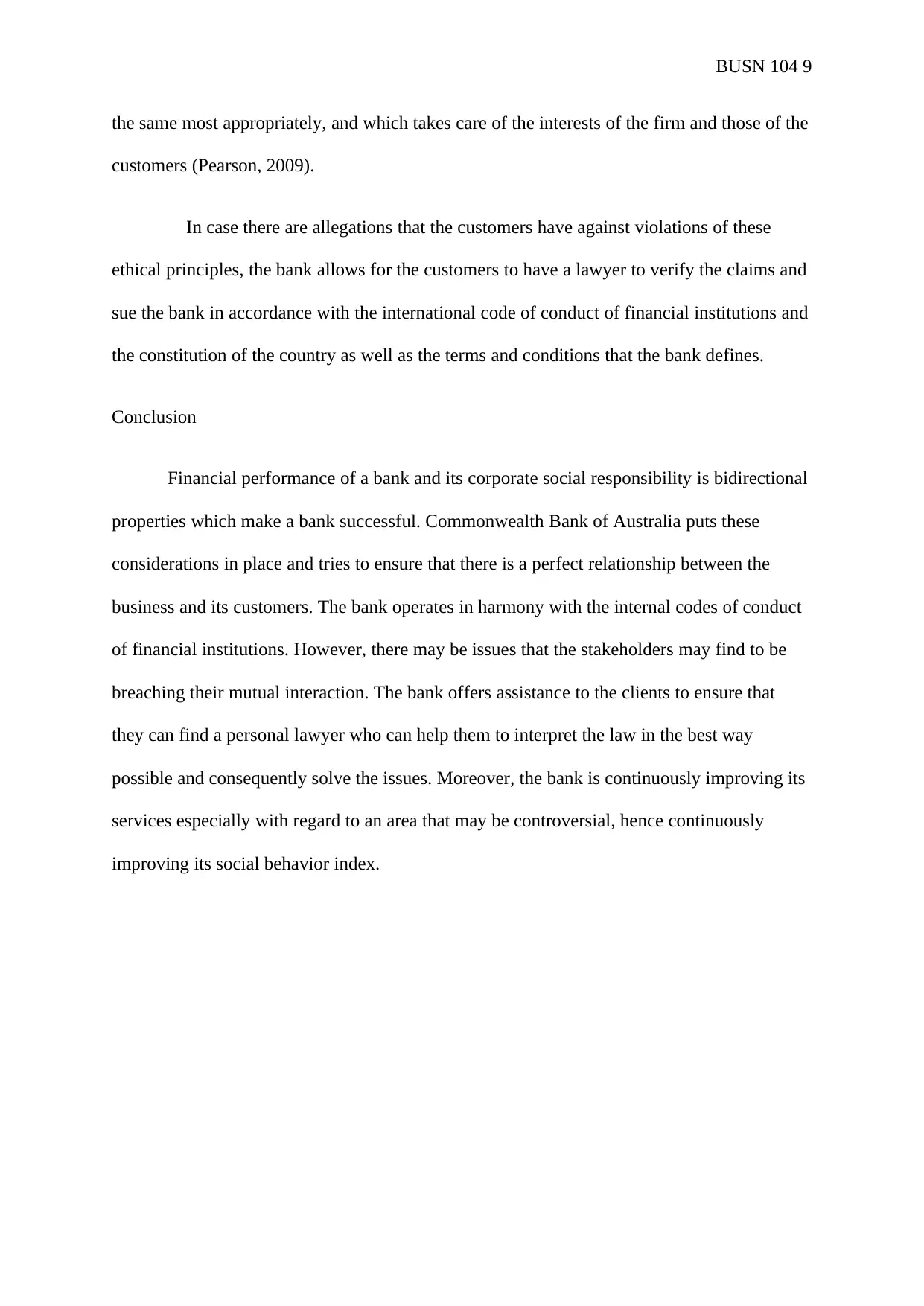
BUSN 104 9
the same most appropriately, and which takes care of the interests of the firm and those of the
customers (Pearson, 2009).
In case there are allegations that the customers have against violations of these
ethical principles, the bank allows for the customers to have a lawyer to verify the claims and
sue the bank in accordance with the international code of conduct of financial institutions and
the constitution of the country as well as the terms and conditions that the bank defines.
Conclusion
Financial performance of a bank and its corporate social responsibility is bidirectional
properties which make a bank successful. Commonwealth Bank of Australia puts these
considerations in place and tries to ensure that there is a perfect relationship between the
business and its customers. The bank operates in harmony with the internal codes of conduct
of financial institutions. However, there may be issues that the stakeholders may find to be
breaching their mutual interaction. The bank offers assistance to the clients to ensure that
they can find a personal lawyer who can help them to interpret the law in the best way
possible and consequently solve the issues. Moreover, the bank is continuously improving its
services especially with regard to an area that may be controversial, hence continuously
improving its social behavior index.
the same most appropriately, and which takes care of the interests of the firm and those of the
customers (Pearson, 2009).
In case there are allegations that the customers have against violations of these
ethical principles, the bank allows for the customers to have a lawyer to verify the claims and
sue the bank in accordance with the international code of conduct of financial institutions and
the constitution of the country as well as the terms and conditions that the bank defines.
Conclusion
Financial performance of a bank and its corporate social responsibility is bidirectional
properties which make a bank successful. Commonwealth Bank of Australia puts these
considerations in place and tries to ensure that there is a perfect relationship between the
business and its customers. The bank operates in harmony with the internal codes of conduct
of financial institutions. However, there may be issues that the stakeholders may find to be
breaching their mutual interaction. The bank offers assistance to the clients to ensure that
they can find a personal lawyer who can help them to interpret the law in the best way
possible and consequently solve the issues. Moreover, the bank is continuously improving its
services especially with regard to an area that may be controversial, hence continuously
improving its social behavior index.
⊘ This is a preview!⊘
Do you want full access?
Subscribe today to unlock all pages.

Trusted by 1+ million students worldwide
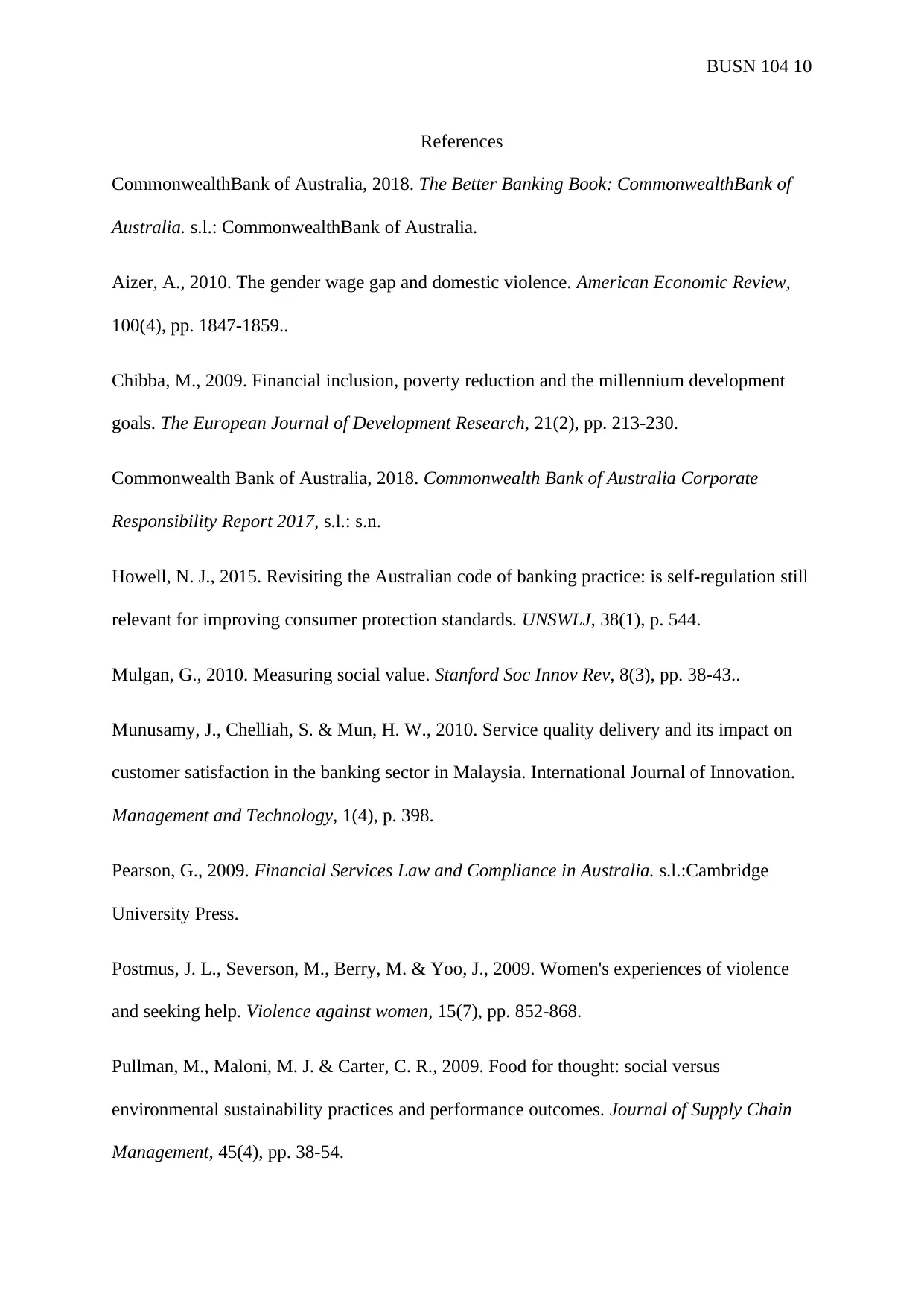
BUSN 104 10
References
CommonwealthBank of Australia, 2018. The Better Banking Book: CommonwealthBank of
Australia. s.l.: CommonwealthBank of Australia.
Aizer, A., 2010. The gender wage gap and domestic violence. American Economic Review,
100(4), pp. 1847-1859..
Chibba, M., 2009. Financial inclusion, poverty reduction and the millennium development
goals. The European Journal of Development Research, 21(2), pp. 213-230.
Commonwealth Bank of Australia, 2018. Commonwealth Bank of Australia Corporate
Responsibility Report 2017, s.l.: s.n.
Howell, N. J., 2015. Revisiting the Australian code of banking practice: is self-regulation still
relevant for improving consumer protection standards. UNSWLJ, 38(1), p. 544.
Mulgan, G., 2010. Measuring social value. Stanford Soc Innov Rev, 8(3), pp. 38-43..
Munusamy, J., Chelliah, S. & Mun, H. W., 2010. Service quality delivery and its impact on
customer satisfaction in the banking sector in Malaysia. International Journal of Innovation.
Management and Technology, 1(4), p. 398.
Pearson, G., 2009. Financial Services Law and Compliance in Australia. s.l.:Cambridge
University Press.
Postmus, J. L., Severson, M., Berry, M. & Yoo, J., 2009. Women's experiences of violence
and seeking help. Violence against women, 15(7), pp. 852-868.
Pullman, M., Maloni, M. J. & Carter, C. R., 2009. Food for thought: social versus
environmental sustainability practices and performance outcomes. Journal of Supply Chain
Management, 45(4), pp. 38-54.
References
CommonwealthBank of Australia, 2018. The Better Banking Book: CommonwealthBank of
Australia. s.l.: CommonwealthBank of Australia.
Aizer, A., 2010. The gender wage gap and domestic violence. American Economic Review,
100(4), pp. 1847-1859..
Chibba, M., 2009. Financial inclusion, poverty reduction and the millennium development
goals. The European Journal of Development Research, 21(2), pp. 213-230.
Commonwealth Bank of Australia, 2018. Commonwealth Bank of Australia Corporate
Responsibility Report 2017, s.l.: s.n.
Howell, N. J., 2015. Revisiting the Australian code of banking practice: is self-regulation still
relevant for improving consumer protection standards. UNSWLJ, 38(1), p. 544.
Mulgan, G., 2010. Measuring social value. Stanford Soc Innov Rev, 8(3), pp. 38-43..
Munusamy, J., Chelliah, S. & Mun, H. W., 2010. Service quality delivery and its impact on
customer satisfaction in the banking sector in Malaysia. International Journal of Innovation.
Management and Technology, 1(4), p. 398.
Pearson, G., 2009. Financial Services Law and Compliance in Australia. s.l.:Cambridge
University Press.
Postmus, J. L., Severson, M., Berry, M. & Yoo, J., 2009. Women's experiences of violence
and seeking help. Violence against women, 15(7), pp. 852-868.
Pullman, M., Maloni, M. J. & Carter, C. R., 2009. Food for thought: social versus
environmental sustainability practices and performance outcomes. Journal of Supply Chain
Management, 45(4), pp. 38-54.
Paraphrase This Document
Need a fresh take? Get an instant paraphrase of this document with our AI Paraphraser
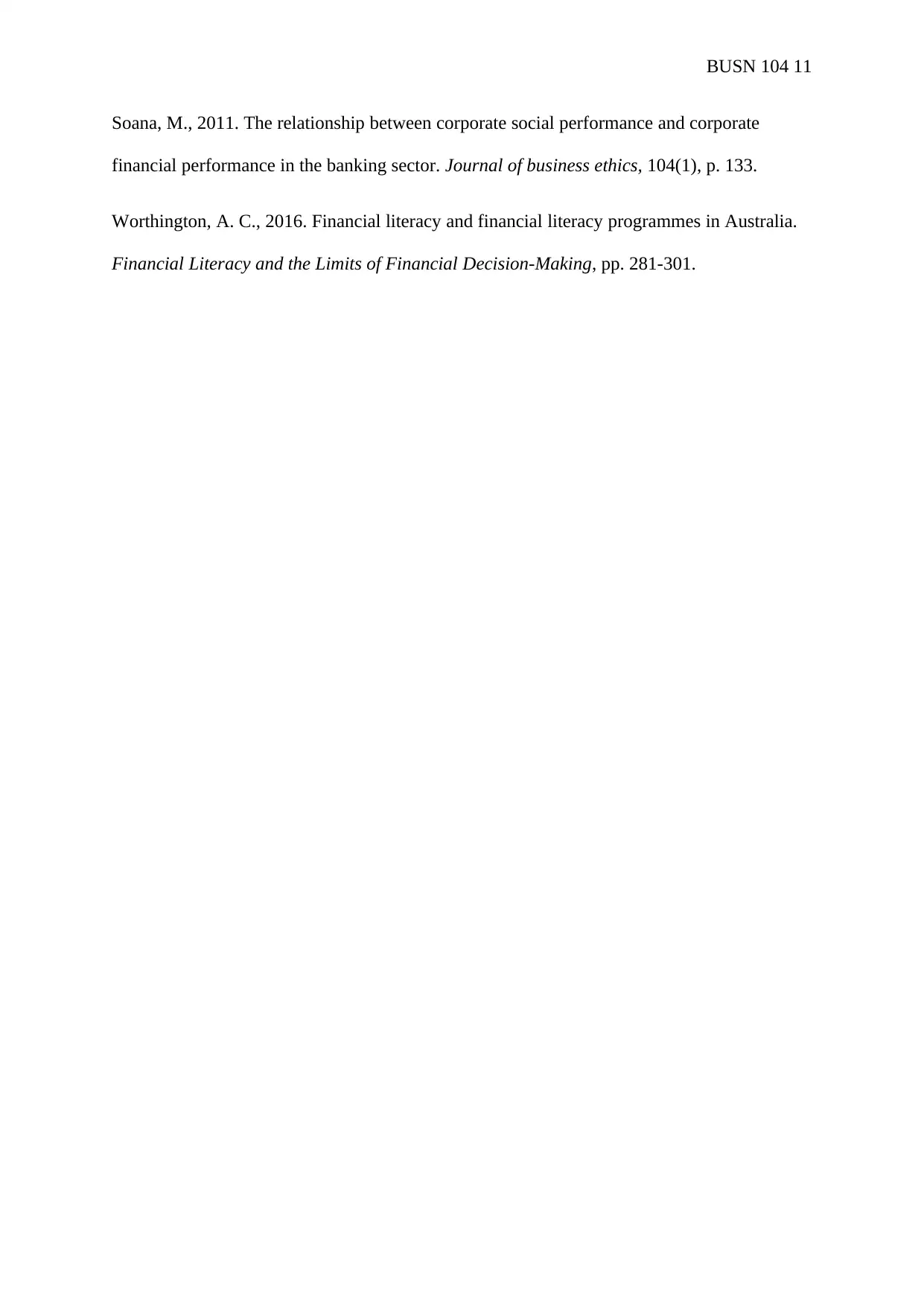
BUSN 104 11
Soana, M., 2011. The relationship between corporate social performance and corporate
financial performance in the banking sector. Journal of business ethics, 104(1), p. 133.
Worthington, A. C., 2016. Financial literacy and financial literacy programmes in Australia.
Financial Literacy and the Limits of Financial Decision-Making, pp. 281-301.
Soana, M., 2011. The relationship between corporate social performance and corporate
financial performance in the banking sector. Journal of business ethics, 104(1), p. 133.
Worthington, A. C., 2016. Financial literacy and financial literacy programmes in Australia.
Financial Literacy and the Limits of Financial Decision-Making, pp. 281-301.
1 out of 11
Related Documents
Your All-in-One AI-Powered Toolkit for Academic Success.
+13062052269
info@desklib.com
Available 24*7 on WhatsApp / Email
![[object Object]](/_next/static/media/star-bottom.7253800d.svg)
Unlock your academic potential
Copyright © 2020–2025 A2Z Services. All Rights Reserved. Developed and managed by ZUCOL.





